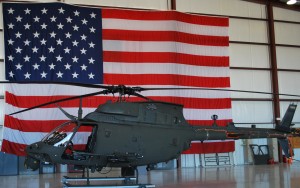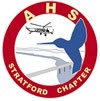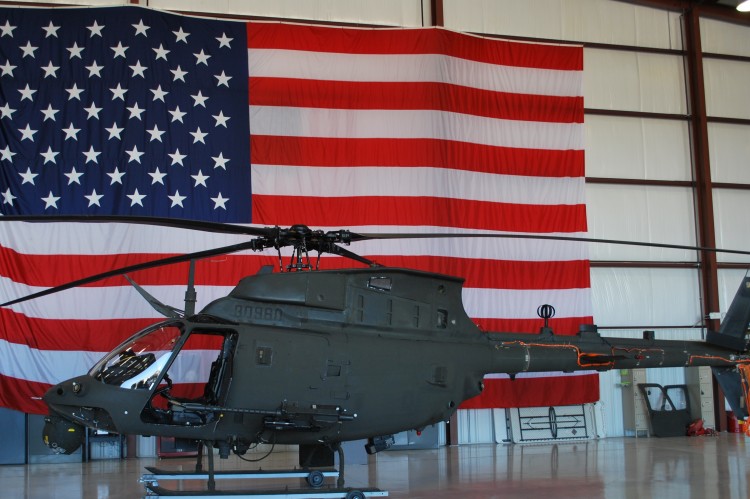 The Bell OH-58A Kiowa was the second of two Light Observation Helicopters (LOHs) ordered by U.S. Army for reconnaissance during the Vietnam War and entered service in 1969. About 2,200 A-model Kiowas were delivered with 317 shp Allison T63-A-700 engines. A portion of the fleet was upgraded to OH-58C standards with more powerful -720 engines and equipment changes starting in 1979. The Army Helicopter Improvement Program (AHIP) begun the same year launched OH-58D remanufacturing in 1981, introducing a four-bladed composite main rotor, Mast-Mounted Sight (MMS), digital “glass” cockpit, and Automatic Target Handover System. The unarmed Kiowa Aeroscout entered service in 1986 and subsequently evolved to the armed OH-58D Kiowa Warrior now in the fleet and the improved OH-58F currently in flight test.
The Bell OH-58A Kiowa was the second of two Light Observation Helicopters (LOHs) ordered by U.S. Army for reconnaissance during the Vietnam War and entered service in 1969. About 2,200 A-model Kiowas were delivered with 317 shp Allison T63-A-700 engines. A portion of the fleet was upgraded to OH-58C standards with more powerful -720 engines and equipment changes starting in 1979. The Army Helicopter Improvement Program (AHIP) begun the same year launched OH-58D remanufacturing in 1981, introducing a four-bladed composite main rotor, Mast-Mounted Sight (MMS), digital “glass” cockpit, and Automatic Target Handover System. The unarmed Kiowa Aeroscout entered service in 1986 and subsequently evolved to the armed OH-58D Kiowa Warrior now in the fleet and the improved OH-58F currently in flight test.
The OH-58D with MMS and initial Honeywell Control Display System (CDS-1) was designed to locate and laser-designate targets from defilade for artillery and attack helicopters. Operation Prime Chance armed select aircraft with Hellfire and Stinger missiles, 70 mm rockets, and 0.50 caliber machine guns to fly from US Navy ships in the Persian Gulf around 1989. The weapons were integrated with monochrome displays for the broader fleet in CDS2, and the Kiowa Warrior went to war in Operation Desert Storm in 1991. The Republic of China received 26 OH-58Ds with CDS2 cockpits starting in 1993. CDS3 with twin Master Control Processor Units appeared in 1996, and a Safety Enhancement Program begun at Bell in 1998 standardized all OH-58Ds on CDS4 with an Improved MCPU.
OH-58A-to-D conversions initially concluded in 1999, but the Kiowa Warrior proved especially valuable in Operations Enduring Freedom and Iraqi Freedom. Wartime attrition reduced the OH-58D fleet to around 330 aircraft, short of current Army requirements. Bell and the Corpus Christi Army Depot (CCAD) are consequently rebuilding battle-damaged OH-58Ds, reclaiming OH-58A fuselages for D-model conversion, and building new OH-58D War Replacement Aircraft to replenish the fleet.
The cancellation of the RAH-66 Comanche armed scout helicopter led the Army to select the Bell ARH-70 Armed Reconnaissance Helicopter (ARH) as a replacement. When rising costs killed the Arapaho ARH in 2008, the Army formulated an OH-58D Life Support 2020 program to enhance Kiowa Warrior availability and trim operating costs. In 2009, the Army itself began integrating a Cockpit And Sensor Upgrade (CASUP) that turns OH-58Ds into OH-58Fs with longer-ranged sensors, intuitive color displays, and a more powerful avionics architecture to integrate Aircraft Survivability Equipment and other systems. The Mast Mounted Sight gives way to a modern, chin-mounted Raytheon AN/AAS-53 Common Sensor Payload shared with the Army MQ-1C Gray Eagle UAS. The chin-mounted sensor is better positioned for urban combat and provides modest weight and drag reductions.
The first OH-58F built in an Army Prototype Integration Facility flew on April 30, 2013. Full Rate Production deliveries from the Corpus Christi Army Depot are scheduled from 2017 to 2025 to give the Army a fleet of 368 OH-58Fs. The US Army meanwhile continues studies of an Armed Aerial Scout (AAS) with superior high-and-hot performance. The Bell Xworx flew a company-owned Kiowa Warrior Block II demonstrator in 2011 with the commercial Model 407 transmission and main rotor, and a wide-chord Model 427 tail rotor. The 970 shp Honeywell HTS 900 turboshaft in the first demonstrator was inherited from the Arapaho. The second Block II demonstrator uses the 650 shp Rolls Royce T703-AD-700A engine of the OH-58F.

